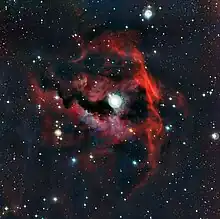| Observation data Epoch J2000 Equinox J2000 | |
|---|---|
| Constellation | Monoceros |
| HD 53367A | |
| Right ascension | 07h 04m 25.5311s[2] |
| Declination | −10° 27′ 15.753″[2] |
| Apparent magnitude (V) | 7.36[3] |
| HD 53367B | |
| Right ascension | 07h 04m 25.4868s[4] |
| Declination | −10° 27′ 15.400″[4] |
| Apparent magnitude (V) | 8.41[3] |
| Characteristics | |
| HD 53367A | |
| Spectral type | B0IV/Ve[5] |
| HD 53367B | |
| Spectral type | B1Ve[6] |
| Astrometry | |
| HD 53367A | |
| Proper motion (μ) | RA: −3.741[2] mas/yr Dec.: +1.772[2] mas/yr |
| Parallax (π) | 0.8199 ± 0.2114 mas[2] |
| Distance | 990±50[7] pc |
| Orbit[7] | |
| Primary | HD 53367Aa |
| Companion | HD 53367Ab |
| Period (P) | 367.7 d |
| Semi-major axis (a) | 2.6 - 2.7 mas |
| Eccentricity (e) | 0.5 |
| Inclination (i) | 53.6 - 55.3° |
| Semi-amplitude (K1) (primary) | 20.3 km/s |
| Details[7] | |
| HD 53367Aa | |
| Mass | 12.19±2.18 M☉ |
| Radius | 4.2 - 4.3 R☉ |
| Luminosity | 11,000 L☉ |
| Surface gravity (log g) | 4.25 - 4.27 cgs |
| Temperature | 28,400 - 28,600 K |
| HD 53367Ab | |
| Mass | 4.90±0.52 M☉ |
| Radius | 2.5 - 8.0 R☉ |
| Luminosity | 377 - 513 L☉ |
| Surface gravity (log g) | 3.32 - 4.34 cgs |
| Temperature | 9,000 - 17,500 K |
| Age | 0.7±0.2 Myr |
| Other designations | |
| Database references | |
| SIMBAD | data |
HD 53367 is a triple star system in the constellation of Monoceros. The primary star was identified as a variable Herbig Ae/Be star in 1989.[6] Its companion, spectroscopically discovered in 2006, is a pre-main-sequence star star with an average separation of 1.7 AU.[1] The star system is embedded in the extended nebula IC 2177.
The binary HD 53367A is part of the hierarchical triple star system RST 3489, with an additional Herbig Ae/Be star HD 53367B of spectral class B1Ve at a projected separation of 0.6″. All stars in the system belong to the star-forming CMa OB1 association.[6] The Hipparcos,[9] Gaia Data Release 2,[10] and Gaia Data Release 3[2] parallax values for HD 53367A are highly discrepant, but the system is thought to be about 1,000 parsecs away.[11][7]
Extended nebula

HD 53367A is a very young and gas-rich system, with most of the gas still obscuring the secondary component HD 53367Ab.[1]
References
- 1 2 3 Pogodin, M. A.; Malanushenko, V. P.; Kozlova, O. V.; Tarasova, T. N.; Franco, G. A. P. (2006). "The Herbig B0e star HD 53367: Circumstellar activity and evidence of binarity". Astronomy and Astrophysics. 452 (2): 551. Bibcode:2006A&A...452..551P. doi:10.1051/0004-6361:20053704.
- 1 2 3 4 5 6 Vallenari, A.; et al. (Gaia collaboration) (2023). "Gaia Data Release 3. Summary of the content and survey properties". Astronomy and Astrophysics. 674: A1. arXiv:2208.00211. Bibcode:2023A&A...674A...1G. doi:10.1051/0004-6361/202243940. S2CID 244398875. Gaia DR3 record for this source at VizieR.
- 1 2 Fabricius, C; Høg, E; Makarov, V. V; Mason, B. D; Wycoff, G. L; Urban, S. E (2002). "The Tycho double star catalogue". Astronomy and Astrophysics. 384: 180–189. Bibcode:2002A&A...384..180F. doi:10.1051/0004-6361:20011822.
- 1 2 Vallenari, A.; et al. (Gaia collaboration) (2023). "Gaia Data Release 3. Summary of the content and survey properties". Astronomy and Astrophysics. 674: A1. arXiv:2208.00211. Bibcode:2023A&A...674A...1G. doi:10.1051/0004-6361/202243940. S2CID 244398875. Gaia DR3 record for this source at VizieR.
- ↑ Tjin A Djie, H. R. E.; et al. (August 2001). "The stellar composition of the star formation region CMa R1 - II. Spectroscopic and photometric observations of nine young stars". Monthly Notices of the Royal Astronomical Society. 325 (4): 1441–1457. arXiv:astro-ph/0103349. Bibcode:2001MNRAS.325.1441T. doi:10.1046/j.1365-8711.2001.04541.x. S2CID 117112792.
- 1 2 3 Halbedel, Elaine M. (1989). "Photometry of Three Herbig be Stars: HD 53367, HD 200775, and HD 259431". Publications of the Astronomical Society of the Pacific. 101: 1004. Bibcode:1989PASP..101.1004H. doi:10.1086/132567. S2CID 119992761.
- 1 2 3 4 Zarrilli, Sebastian A.; Kraus, Stefan; Kreplin, Alexander; Monnier, John D.; Gardner, Tyler; Mérand, Antoine; Morrell, Sam; Davies, Claire L.; Labdon, Aaron; Ennis, Jacob; Setterholm, Benjamin; Le Bouquin, Jean-Baptiste; Anugu, Narsireddy; Lanthermann, Cyprien; Schaefer, Gail; Ten Brummelaar, Theo (2022). "Characterising the orbit and circumstellar environment of the high-mass binary MWC 166 A". Astronomy and Astrophysics. 665: A146. arXiv:2207.02836. Bibcode:2022A&A...665A.146Z. doi:10.1051/0004-6361/202243957. S2CID 250311299.
- ↑ "HD 53367". SIMBAD. Centre de données astronomiques de Strasbourg. Retrieved 30 March 2021.
- ↑ Van Leeuwen, F. (2007). "Validation of the new Hipparcos reduction". Astronomy and Astrophysics. 474 (2): 653–664. arXiv:0708.1752. Bibcode:2007A&A...474..653V. doi:10.1051/0004-6361:20078357. S2CID 18759600.
- ↑ Brown, A. G. A.; et al. (Gaia collaboration) (August 2018). "Gaia Data Release 2: Summary of the contents and survey properties". Astronomy & Astrophysics. 616. A1. arXiv:1804.09365. Bibcode:2018A&A...616A...1G. doi:10.1051/0004-6361/201833051. Gaia DR2 record for this source at VizieR.
- ↑ Siebenmorgen, R.; Scicluna, P.; Krełowski, J. (2018), "Far-infrared emission of massive stars", Astronomy & Astrophysics, 620: A32, arXiv:1809.06658, Bibcode:2018A&A...620A..32S, doi:10.1051/0004-6361/201833546, S2CID 119202458
